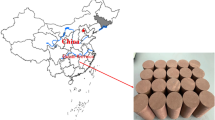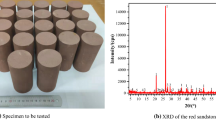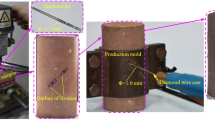Abstract
In the field of high-temperature underground excavations, previous scholars often focused on the seepage characteristics of intact host rock after high-temperature treatment. However, relatively little is known about the coupled thermo-hydro-mechanical (THM) responses of the damaged host rock in excavation damage zone under real-time ultra-high temperature and triaxial stress/seepage pressure (RTUHTTSSP). Therefore, using a self-designed triaxial testing system coupled with THM response system, the permeability evolution of sandstone with varying damage degrees under RTUHTTSSP was measured in this study. Then, mercury injection measurements were carried out on these specimens subjected to coupled THM conditions. The results show that (1) under RTUHTTSSP, permeability/porosity does not continue to increase with increasing temperature as expected. They show a strong dependence on the interaction of temperature field, stress field, seepage field, and damage regime. At 300 °C, the permeability/porosity of 0–0.8-damaged specimens is expected to decrease due to the closure of internal pores/fissures. However, at 450 and 300 °C, permeability/porosity of the 0.8–0.9-damaged specimens is expected to increase vertically due to the generation of the through-going macrocracks. Subsequently, with the continuous increase in the temperature, the permeability/porosity decreases slightly due to the fracturing/compression of the propping asperities. (2) The relationship between permeability and seepage pressure is closely related to the damage degree. For 0–0.6-damaged specimens, the permeability first decreases and then increases with the increase in seepage pressure. For 0.7–0.8-damaged specimens, the permeability increases with the increase in seepage pressure. The research results of this study can provide theoretical basis for the evaluation of stability of high-temperature underground excavation.

























Similar content being viewed by others
References
Alkan H, Cinar Y, Pusch G (2007) Rock salt dilatancy boundary from combined acoustic emission and triaxial compression tests. Int J Rock Mech Min Sci 44(1):108–119
Basu A, Mishra DA, Roychowdhury K (2013) Rock failure modes under uniaxial compression Brazilian and point load tests. Bull Eng Geol Environ 72(3–4):457–475
Chen H, Hu ZY (2003) Some factors affecting the uniaxial strength of weak sandstones. Bull Eng Geol Environ 62(4):323–332
Cieślik J (2018) Dilatancy as a measure of fracturing development in the process of rock damage. Open Geosci 10(1):484–490
Ding QL, Ju F, Song SB et al (2016) An experimental study of fractured sandstone permeability after high-temperature treatment under different confining pressures. J Nat Gas Sci Eng 34:55–63
Fan JY, Jiang DY, Liu Wei, Wu Fei, Chen Jie, JJk Daemen (2019) Discontinuous fatigue of salt rock with low-stress intervals. Int J Rock Mech Min Sci 11:577–586. https://doi.org/10.1016/j.ijrmms.2019.01
Fan JY, Liu Wei, Jiang DY, Jie Chen, William NT, JJK Daemen (2020a) Time interval effect in triaxial discontinuous cyclic compression tests and simulations for the residual stress in rock salt. Rock Mech Rock Eng 53(9):4061–4076. https://doi.org/10.1007/s00603-020-02150-y
Fan JY, Xie HP, Chen Jie, Deyi Jiang, Cunbao Li, William Ngaha Tiedeu, Julien Ambre (2020b) Preliminary feasibility analysis of a hybrid pumped-hydro energy storage system using abandoned coal mine goafs. Appl Energy 258:114007. https://doi.org/10.1016/j.apenergy.2019.114007
Feng M, Wu J et al (2018) Experimental investigation on the seepage property of saturated broken red sandstone of continuous gradation. Bull Eng Geol Environ 77(3):1167–1178
Izadi G, Elsworth D (2015) The influence of thermal-hydraulic-mechanical-and chemical effects on the evolution of permeability seismicity and heat production in geothermal reservoirs. Geothermics 53:385–395
Kang YF, Fan JY, Fan Deyi, Li JZ (2021) Influence of geological and environmental factors on the reconsolidation behavior of fine granular salt. Nat Resour Res 30(1):805–826. https://doi.org/10.1007/s11053-020-09732-1
Lü C, Sun Q, Zhang W et al (2017) The effect of high temperature on tensile strength of sandstone. Appl Therm Eng 111:573–579
Lu Y, Wang L, Sun X et al (2017) Experimental study of the influence of water and temperature on the mechanical behavior of mudstone and sandstone. Bull Eng Geol Environ 76(2):645–660
Luo J, Wang L (2011) High-temperature mechanical properties of mudstone in the process of underground coal gasification. Rock Mech Rock Eng 44(6):749–754
Meng T, Liu R, Meng X et al (2019) Evolution of the permeability and pore structure of transversely isotropic calcareous sediments subjected to triaxial pressure and high temperature. Eng Geol 253:27–35
Meng T, You YC, Chen J et al (2017) Investigation on the permeability evolution of gypsum interlayer under high temperature and triaxial pressure. Rock Mech Rock Eng 50(8):2059–2069
Meng T, Yongbing X, Ma J et al (2021). Evolution of permeability and microscopic pore structure of sandstone and its weakening mechanism under coupled thermo-hydro-mechanical environment subjected to real-time high temperature. Eng Geol 280:105955
Meng T, Guangwu X, Jiwei M, Yang Y, Liu W, Zhang J, Bosen J, Fang S, Ren G (2020) Mixed mode fracture tests and inversion of FPZ at crack tip of overlying strata in underground coal gasification combustion cavity under real-time high temperature condition. Eng Fract Mech 239:107298
Najafi M, Jalali SME, KhaloKakaie R (2014) Thermal–mechanical–numerical analysis of stress distribution in the vicinity of underground coal gasification (UCG) panels. Int J Coal Geol 134:1–16
Niu S, Zhao Y, Hu Y (2014) Experimental ivestigation of the temperature and pore pressure effect on permeability of lignite under the in situ condition. Transp Porous Media 101(1):137–148
Ogata S, Yasuhara H, Kinoshita N et al (2018) Modeling of coupled thermal-hydraulic-mechanical-chemical processes for predicting the evolution in permeability and reactive transport behavior within single rock fractures. Int J Rock Mech Min Sci 107:271–281
Ozguven A, Ozcelik Y (2013) Investigation of some property changes of natural building stones exposed to fire and high heat. Constr Build Mater 38:813–821
Pan PZ, Feng XT, Huang XH et al (2009) Coupled THM processes in EDZ of crystalline rocks using an elasto-plastic cellular automaton. Environ Geol 57(6):1299
Peng HH, Fan JY, Xiong Zhang, Jie Chen, Zongze Li, Deyi Jiang, Chun Liu (2020) Computed tomography analysis on cyclic fatigue and damage properties of rock salt under gas pressure. Int J Fatigue 134:105523. https://doi.org/10.1016/j.ijfatigue.2020.105523
Ranjith PG, Viete DR, Chen BJ et al (2012) Transformation plasticity and the effect of temperature on the mechanical behaviour of Hawkesbury sandstone at atmospheric pressure. Eng Geol 151:120–127
Shao S, Ranjith PG, Wasantha PLP et al (2015) Experimental and numerical studies on the mechanical behaviour of Australian Strathbogie granite at high temperatures: an application to geothermal energy. Geothermics 54:96–108
Shi X, Jing H, Yin Q et al (2020) Investigation on physical and mechanical properties of bedded sandstone after high-temperature exposure. Bull Eng Geol Environ 79:2591–2606
Sirdesai NN, Mahanta B, Ranjith PG et al (2019) Effects of thermal treatment on physico-morphological properties of Indian fine-grained sandstone. Bull Eng Geol Environ 78(2):883–897
Sirdesai NN, Singh TN, Ranjith PG et al (2017) Effect of varied durations of thermal treatment on the tensile strength of red sandstone. Rock Mech Rock Eng 50(1):205–213
Siren T, Kantia P, Rinne M (2015) Considerations and observations of stress-induced and construction-induced excavation damage zone in crystalline rock. Int J Rock Mech Min Sci 73:165–174
Somerton WH, Boozer GD (1960) Thermal characteristics of porous rocks at elevated temperatures. J Pet Technol 12(06):418–422
Su F, Nakanowataru T, Itakura K et al (2013) Evaluation of structural changes in the coal specimen heating process and UCG model experiments for developing efficient UCG systems. Energies 6(5):2386–2406
Sun H, Sun Q, Deng W et al (2017) Temperature effect on microstructure and P-wave propagation in Linyi sandstone. Appl Therm Eng 115:913–922
Tan X, Chen W, Yang D et al (2014) Study on the influence of airflow on the temperature of the surrounding rock in a cold region tunnel and its application to insulation layer design. Appl Therm Eng 67(1–2):320–334
Taron J, Elsworth D, Min KB (2009) Numerical simulation of thermal-hydrologic-mechanical-chemical processes in deformable fractured porous media. Int J Rock Mech Min Sci 46(5):842–854
Viete DR, Ranjith PG (2006) The effect of CO2 on the geomechanical and permeability behaviour of brown coal: implications for coal seam CO2 sequestration. Int J Coal Geol 66(3):204–216
Wang F, Cao P, Cao RH et al (2019) The influence of temperature and time on water-rock interactions based on the morphology of rock joint surfaces. Bull Eng Geol Environ 78(5):3385–3394
Wu G, Wang Y, Swift G, Chen J (2013) Laboratory investigation of the effects of temperature on the mechanical properties of sandstone. Geotech Geol Eng 31(2):809–816
Xin L, Wang Z, Huang W et al (2014) Temperature field distribution of burnt surrounding rock in UCG stope. Int J Min Sci Technol 24(4):573–580
Yang SQ, Huang YH, Tian WL et al (2019) Effect of high temperature on deformation failure behavior of granite specimen containing a single fissure under uniaxial compression. Rock Mech Rock Eng 52(7):2087–2107
Yang SQ, Ranjith PG, Jing HW et al (2017) An experimental investigation on thermal damage and failure mechanical behavior of granite after exposure to different high temperature treatments. Geothermics 65:180–197
Yang SQ, Tian WL, Huang YH (2018) Failure mechanical behavior of pre-holed granite specimens after elevated temperature treatment by particle flow code. Geothermics 72:124–137
Yang Z, Zhang C (2019) Mode I fracture toughness test and fractal character of fracture trajectory of red sandstone under real-time high temperature. Adv Mater Sci Eng
Yin S, Dusseault MB, Rothenburg L (2011) Coupled THMC modeling of CO2 injection by finite element methods. J Pet Sci Eng 80(1):53–60
Yu J, Xu W, Jia C et al (2019) Experimental measurement of permeability evolution in sandstone during hydrostatic compaction and triaxial deformation. Bull Eng Geol Environ 78(7):5269–5280
Zhang W, Sun Q, Hao S et al (2016) Experimental study on the variation of physical and mechanical properties of rock after high temperature treatment. Appl Therm Eng 98:1297–1304
Zhang W, Sun Q, Zhu S et al (2017) Experimental study on mechanical and porous characteristics of limestone affected by high temperature. Appl Therm Eng 110:356–362
Zhang WQ, Sun Q, Zhu YM, Guo WH (2018) Experimental study on response characteristics of micro-macroscopic performance of red sandstone after high-temperature treatment. J Therm Anal Calorim 136(5):1935–1945
Zhu T, Jing H, Su H, Yin Q, Du M, Han G (2016) Physical and mechanical properties of sandstone containing a single fissure after exposure to high temperatures. Int J Min Sci Technol 26(2):319–325
Zuo J, Li Y, Zhang X et al (2018) The effects of thermal treatments on the subcritical crack growth of Pingdingshan sandstone at elevated high temperatures. Rock Mech Rock Eng 51(11):3439–3454
Zuo JP, Wang JT, Sun YJ et al (2017) Effects of thermal treatment on fracture characteristics of granite from Beishan a possible high-level radioactive waste disposal site in China. Eng Fract Mech 182:425–437
Zuo JP, Wang XS, Mao DQ (2014) SEM in-situ study on the effect of offset-notch on basalt cracking behavior under three-point bending load. Eng Fract Mech 131:504–513
Acknowledgements
The author wishes to thank Xufeng Liang for his contribution to the English grammar checking.
Funding
The authors received financial support from the Youth Program of National Natural Science Foundation of China (Grant No. 51904195), Scientific and Technological Innovation Programs of Higher Education Institutions in Shanxi (2019L0640), Key Research and Development Project of Shanxi Province (201903D121025), Fundamental Research Program of Shanxi Province (201901D211300; 20191142), TYUST-SRIF (20172018), and Outstanding Doctoral Award Fund in Shanxi Province (20192032).
Author information
Authors and Affiliations
Corresponding author
Ethics declarations
Conflict of interest
The authors declare no competing interests.
Rights and permissions
About this article
Cite this article
Meng, T., Li, E., Xue, Y. et al. Experimental study on permeability and porosity evolution of host rock with varying damage degrees in excavation damaged area under real-time ultra-high temperature and triaxial stress/seepage pressure condition. Bull Eng Geol Environ 80, 8075–8097 (2021). https://doi.org/10.1007/s10064-021-02408-x
Received:
Accepted:
Published:
Issue Date:
DOI: https://doi.org/10.1007/s10064-021-02408-x




